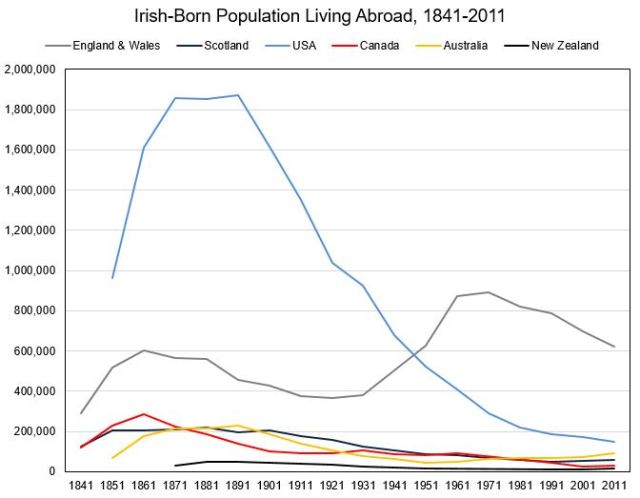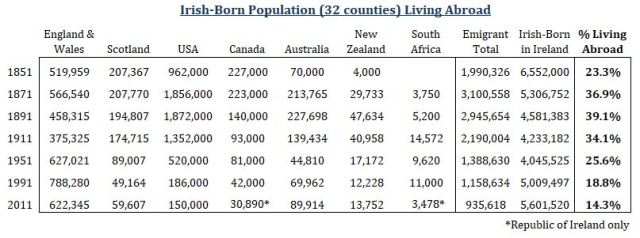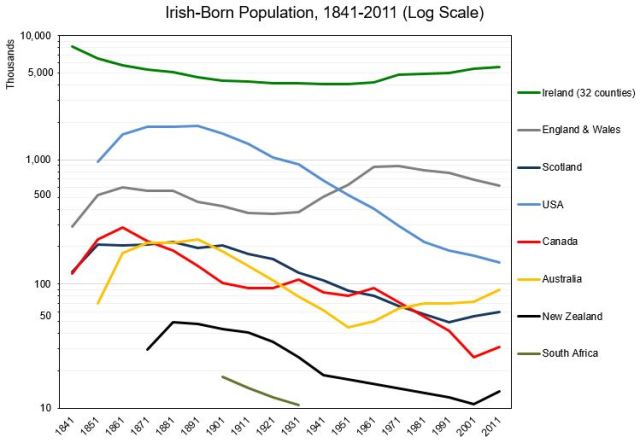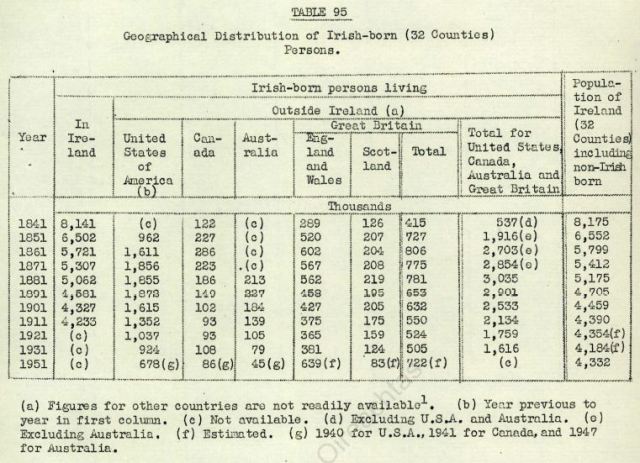


While Ireland’s population collapsed after the Famine and continued to decline into the 20th century, the total Irish-born population was obviously more stable. In the 1880-90s about 40% of those born in Ireland had emigrated. The emigrant stock did fall thereafter, as outflow declined and first-generation emigrants passed away. Those born to Irish emigrants abroad would become part of the diaspora, at least if they identified as partly “Irish”, however statistics on ethnic populations are much harder to come by.
Census data is never completely accurate. And problems get larger the older the source. It’s quite possible that Irish populations were under-counted after the Famine in some countries. Indeed under-counting was an issue in Ireland too. The 1841 Census is considered to understate the island’s pre-Famine population. A chart with Ireland’s population in 1841 (or thereabouts) at 8.5 million instead of 8.1 million was posted here. That chart shows Irish population falling because of the Famine deaths, unlike the one above.
As the bulk of the Irish emigrated to Britain and the United States, it can be difficult to show other countries’ trends in graphs with a nominal scale. The first graph in log scale, with Irish-born population living in Ireland and South Africa, is below.

Sources
To my knowledge, the most comprehensive book on this subject is Donald Akenson’s “The Irish Diaspora”. It includes statistics on Irish emigration from mid-19th to mid-20th centuries. Another good source are the chapters in another book called “The Irish Diaspora” edited by Andy Bielenberg. The Commission on Emigration’s report (1954) also had tabulation on geographical distribution of Irish-born persons, which is below.

Additionally there are estimates made by academics for some of the years marked “Not available” (see country notes below). Surprisingly it’s often harder to find more recent statistics. As the number of Irish immigrants declined, counting them was perhaps not as important. Ireland is sometimes counted with the “British Isles” or “Northern Europe”. The other complication is partition. In several countries there is no data on people born in Northern Ireland, although approximations are possible.
The country notes:
- United States: From 1960-2000: “Historical Census Statistics on the Foreign-Born Population of the United States: 1850-2000”. 2011 can be found on the US Census Bureau’s website. Northern Ireland is included in the UK total, but as England and Scotland are available to subtract from UK total, an estimate of 30,000 is used.
- Canada: Unfortunately there’s a lack of data from 1961. There appears to be no data for Ireland from 1971-1991, only British Isles and Northern Europe. And since 1961 there has been no available data on Northern Irish-born. Damien Courtney’s estimate of 40,000 for 1991 is included. Census totals for Republic of Ireland are available on CanadaStat for 2001 and 2011.
- England & Wales: HistPop is an excellent source for British and Irish Census until 1940s, however thereafter British Censuses can be hard to find. Akenson provides 1961 and 1971 data (page 198). And 1981, 1991, 2001 and 2011 can be found on the ONS’s Nomis website.
- Scotland: Akenson above for 1961 and 1971. It appears that 1981 is not available online. 1991, 2001 and 2011 can be found on Scotland’s Census website.
- Australia: Estimates for 1851 come from Damien Courtney and 1861-71 is from Charles Price’s 1984 working paper. Australian Censuses from 1911 to 2016 are available on the Australian Bureau of Statistics website.
- New Zealand: Akenson has data from 1881 to 1951 (page 68). 1961, 1971 and 1981 are not available online at present. Census data for 1991, 2001 and 2013 (2011 Census was cancelled because of the Christchurch earthquake) can be found on StatsNZ.
- South Africa: Not included all visualizations, as Irish population was usually below 10,000, but Irish-born data can be found Akenson (page 134) and Donal McCracken’s chapter in “The Irish Diaspora” (screenshot can be found here). According to StatSA (via email) the number born in “Ireland” was 4,704 in 2001 and 3,478 in 2011.
Rest of World
The data visualizations include the bulk of Irish emigrants to the present day. However, thousands also emigrated to other countries. Andy Bielenberg’s rough estimate of “Other Overseas” emigration was 38,000 between 1815 and 1910. There were small Irish communities in Latin America, especially Argentina. Estimates of the Irish Argentine population vary considerably, though it’s likely that a couple thousand Irish-born lived there in the late 19th century.
The Irish featured prominently in the British Empire. As noted hundreds of thousands settled in Australia, Canada and New Zealand. The Irish often had a disproportionate share of army, civil service and commercial jobs in the Empire. About 40% (16,000) of the army and company soldiers in 1850s British India were Irish-born. The Indian Census counted 16,000 Irish in 1871 and 12,000 in 1911.
Irish presence in continental Europe was small in the 19th and 20th centuries, though possibly amounted to a couple thousand overall. It should be possible to do a long-term series for the larger countries, but data is not readily available, at least in English. Today there are several thousand in every medium to large EU country. As long as freedom of movement remains these populations are likely to grow.
The United Nations estimated that there were 880,000 Irish-born living abroad in 2015. (Note: this should be Republic of Ireland only, so it’s lower than the table above). Almost 90% live in the countries mentioned at the start, but the numbers living in the rest of the world is rising. In 1990 about 95% of Irish emigrants lived in Britain, North America or Australia/New Zealand. And as Ciara Kenny of Irish Times notes, the UN figures do not have figures for Asia and Middle East, which may now be home to 12,000 Irish people.
Again, there a lack of data for Northern Ireland. But assuming their inclusion would increase the Republic of Ireland’s total by a quarter puts the numbers living in the ‘non-traditional’ places at easily over 100,000. This would imply that there’s over 1 million Irish-born (32 counties) people living abroad today.
